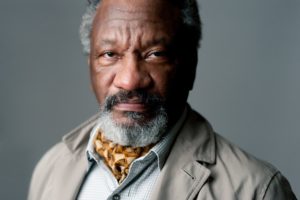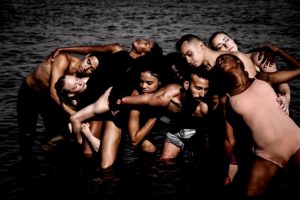Staging Race and Climate Change: Seattle’s Donald Byrd moves the conversation forward - Vancouver Ballet Society
- Home
- Features 2020 - 2023
- Staging Race and Climate Change: Seattle’s Donald Byrd moves the conversation forward

By Gigi Berardi
Donald Byrd’s season-long Race and Climate Change project grew out of his desire to use dance as an instrument for social change and to encourage conversations around community concerns. The seasoned choreographer, who last year received a prestigious Doris Duke Artist Award, sees a social-inquiry focus as central to the mission of his Seattle-based Spectrum Dance Theater (SDT). “Always before I was exploring such issues as an artist, but the institution itself had not leaned into it so much. That’s changing,” he says. This applies to the board, the company and the students in SDT’s school as well, who have been presenting projects on race and climate change throughout the year. “The younger children may not have the same degree of sophistication, but their work shows they are clearly thinking about all the issues.”
Byrd’s ideas about producing work that links race with climate change began when he asked his professionally oriented academy students about their future. Their response: the future was frightening. “I heard the students and suddenly I got really afraid,” admits Byrd. “And I thought, what am I personally doing to move the conversation forward?”

It is the future around the race-climate change connection that Byrd most wants to explore — and people of colour are a vital part of that future. This was recognized, he says, by African-American science fiction writers like Octavia Butler and Samuel R. Delany. “The future they’re projecting, the future I’m projecting, most certainly includes black people in a highly adaptive future.”
The Race and Climate Change project opens on March 30 with “Wake-Up,” the first of two conversations with Seattle arts curator Vivian Phillips. This is followed by Byrd’s Pool (opening April 2) and After (April 9). Pool is a site-specific installation that takes place at Madrona Beach on Lake Washington next to SDT’s studios; After is performed in a concert hall.
Pool uses many elements of the lake site such as platforms, benches and a bridge, but also includes visual projections. “The feeling I want for the audience is one of immersion,” Byrd explained last February after a rehearsal. “That is the idea of ‘the pool.’ It’s a challenging location for the dancers to be in since they need to move in a real location as opposed to a carefully controlled dance space with level floors and smooth surfaces. I want the audience to see that.” Byrd adds that the “language of the pieces” will evolve as he continues to work with the dancers.
During the performance, the audience will see dancers moving while large images of climate change activist Greta Thunberg are projected and excerpts from some of her speeches are heard. Says Byrd, “In these moments all ‘stage action’ stops [in deference to the] omnipresent reminder of how we, these current living generations, are not heeding her warnings.”
In the concert hall, however, Byrd says that “the abstract nature of the dancing can be accentuated, climate change is happening, and we are in the presence of altered realities. People are going to see the kind of rigour in my work that they usually expect — technical, athletic, challenging, with dynamic movement and non-conventional structures.”
Why choreograph for both outdoor spaces and the more typical concert hall? “It’s the nature of the subject matter,” says Byrd. “If you’re interested in it and have any kind of social conscience that you want to put forward, you need to use various and multiple strategies, and that includes venues. Race and climate change work needs to emerge in an open environment, and then a different kind of storytelling can happen in a concert hall.”

As for engaging people in conversation around the topic of race, Byrd says, “Seattle is considered to be progressive, maybe even immune to racism. People here acknowledge they are privileged, but say we don’t need to talk about race. I think we do.”
Talking about race in terms of big ideas can be problematic. Byrd notes that we can talk about racism in the context of “white supremacy — a big, loaded idea.” But rather than invoke guilt, he would prefer to elicit curiosity and reflection on how we as individuals participate in racism unknowingly. “We need to examine our institutions and the racist assumptions operating there — especially in police, government and health care — without eliciting guilt, which, he says, “drives people away from a conversation; that’s part of others’ strategy, it’s not part of mine.”
The choreographer expects a lot from his dancers, including producing material they themselves create. He reflects on how those expectations translated in the past into what he says was almost bullying, as he sought to transform the dancers, moving them farther, pushing them into a completely different performing realm. The volatile Byrd is still demanding, but he sees himself now as more patient with his dancers. He recognizes that his own training was complicated and that influences how he works with dancers today.
Byrd grew up in Florida “at the end of the Jim Crow era, when racism was rampant.” He studied classical music early on, then theatre history and criticism at Yale, and also trained at the London Contemporary Dance School, Joffrey Ballet School and the Ailey School. He performed for Kathryn Posin and, briefly, Twyla Tharp, who accentuated his insecurities about being a strong technical dancer, “I really worked hard to be that technical dancer for her — and it didn’t help that I felt disadvantaged coming to dance so late. I was always trying to catch up, all the while seeking approval and validation.” He then danced as a company member with Gus Solomons, jr, for several years, in part to get a good foundation in the Merce Cunningham technique he so admired.
Reflecting back, Byrd acknowledges: “I had a lot of anger. How could I not? I was a young black man trying to dance in a racist America, and, at the same time, dealing with my own private struggles.” Dancing provided a way to manage his anger and rage. “It fuelled my dancing,” admits Byrd, “and virtuosity and extreme technicality became the mechanism for expressing it.”
As an artistic director, Byrd feels, “I’ve rehabilitated myself as a person and as a company director in terms of how I work with dance artists — and I am happy with that. That strategy is absolutely critical for this Race and Climate Change program. I am asking the dancers to step into territory with which they are unfamiliar, and to trust me, as collaborators.”
He wants his dancers to engage with what they are doing in this all-important season. “These are a remarkable set of human beings,” Byrd adds, “and I feel privileged and honoured to work with them and to have who they are as people and as artists made available to me to create the work I am doing.”

